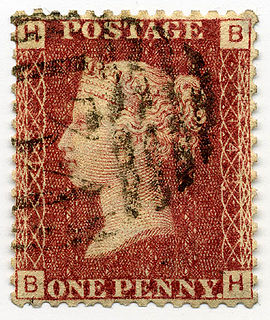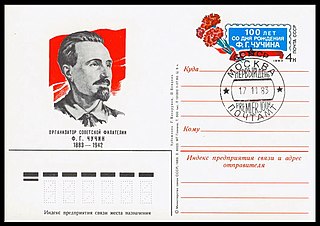
A Zemstvo stamp was a Russian local stamp used widely in rural areas from 1865. It was named after the Zemstvo local administrative districts or uyezds that were created in 1864. The stamps ceased at about the time of the 1917 Russian revolution.

A Zemstvo stamp was a Russian local stamp used widely in rural areas from 1865. It was named after the Zemstvo local administrative districts or uyezds that were created in 1864. The stamps ceased at about the time of the 1917 Russian revolution.
The Russian post in the nineteenth century was a monopoly of the state through the Imperial Post. Most state post offices, however, were in towns, leaving many rural areas a long distance from the nearest post office. The Zemstvo post (or Rural post) was introduced in 1864 to fill this gap and at first it operated without official approval. [1] In 1870 a law was passed formalising the arrangements and which stated that "The Rural post is authorised to carry ordinary correspondence, also journals, circulars, remittances, registered letters, and other mail from the post town, to all more or less distant portions of the district as may be deprived of postal communications." [2]
The law also stated that "The Rural post is authorised to employ special postage stamps on the express understanding that their design differs entirely from those used by the Imperial Post". [2] The postmen were also not allowed to use the post-horn emblem of the Imperial Post on their bags. [3]
The first Zemstvo post was established at Vetluga in 1864 but no stamps were used. [3]
According to Chuchin's catalogue, at least 3000 different Zemstvo stamps were issued, however, records are incomplete and it is likely that there are many still to be discovered.
The first Zemstvo stamp was issued by Schlisselburg in September 1865. According to Chuchin, in 1864 there were 36 Zemstvo governments with 371 districts and stamps were used in 162 districts. By 1892 there was a Zemstvo post in 150 districts but not all issued stamps and in some the post was free. [3]

Unused Zemstvo stamps were highly appreciated among the early collectors. For example, stamps of the most recent issues were 3 to 5 times more expensive than their real price. Rates of stamps of older issues increased in geometrical progression. For some stamps of the first issues, prices were inflated by dealers up to 400 rubles and more. High value of unused Zemstvo stamps was due to the fact that they had not been collected by philatelists in the 1860s. As for used stamps, they were valued much cheaper, yet stamps of the first issues being expensive, too. Zemstvo stamps were in great demand among foreign philatelists. [4]
Zemstvo stamps were officially sanctioned local stamps. As such they appear only in specialised books and catalogues. Several books about Zemstvo stamps were published in the French and German languages. The book Description of the Russian Zemstvo Stamps, Envelopes and Parcels by D. Chudovsky was issued in Kiev in 1888 and was also very popular. [4]
A number of catalogues were produced in Germany and Russia before the revolution but some are incomplete and other were published before the cessation of the service and therefore do not give a full history of the stamps. The principal catalogue in English is the Chuchin catalogue of 1925 as updated by Barefoot. Chuchin numbers are widely used to identify Zemstvos. Recently, as collecting Zemstvos has become more popular, new catalogues have started to appear in the Russian language.
| Wikimedia Commons has media related to Zemstvo stamps . |

Philately is the study of postage stamps and postal history. It also refers to the collection, appreciation and research activities on stamps and other philatelic products. Philately involves more than just stamp collecting or the study of postage; it is possible to be a philatelist without owning any stamps. For instance, the stamps being studied may be very rare or reside only in museums.

Stamp collecting is the collecting of postage stamps and related objects. It is an area of philately, which is the study or study and collection of stamps. It has been one of the world's most popular hobbies since the late nineteenth century with the rapid growth of the postal service, as a never-ending stream of new stamps was produced by countries that sought to advertise their distinctiveness through their stamps.

Indian postal systems for efficient military and governmental communications had developed long before the arrival of Europeans. When the Portuguese, Dutch, French, Danish and British conquered the Marathas who had already defeated the Mughals, their postal systems existed alongside those of many somewhat independent states. The British East India Company gradually annexed the other powers on the sub-continent and brought into existence a British administrative system over most of modern-day India, with a need to establish and maintain both official and commercial mail systems.

This a survey of the postage stamps and postal history of the Russian Empire, the Soviet Union and the modern Russian Federation.

The Far Eastern Republic, sometimes called the Chita Republic, existed from April 1920 to November 1922 in the easternmost part of Siberia. It was formed from the Amur, Transbaikal, Kamchatka, Sakhalin, and Primorye regions. In theory, it extended from Lake Baikal to Vladivostok but, in May 1921, the Priamur and Maritime Provinces seceded. Although nominally independent, it was largely controlled by the RSFSR and its main purpose was to be a democratic buffer state between the RSFSR and the territories occupied by Japan during the Russian Civil War to avoid war with Japan. Initially, its capital was Verkhneudinsk, but from October 1920 it was Chita. On 15 November 1922, after the war ended and the Japanese withdrew from Vladivostok, the Far Eastern Republic was annexed by Soviet Russia.

Karelia has appeared in philately several times; first as a breakaway republic from Soviet Russia in 1922, later when Eastern Karelia was occupied by Finland during the Continuation War of 1941 to 1944, and in the post-Soviet period when provisional stamps and cinderellas were issued. Additionally, there were Zemstvo stamps used in the early 20th century on the territory of the contemporary Republic of Karelia.

The Mexican postal system has its roots in the Aztec system of messengers which the Spanish adopted after the Conquest. A postal service was established in 1580, mainly to communicate between the viceroyalty of New Spain with the motherland Spain. During the 18th century, Spain established a formal postal system with regular routes. In 1856, Mexico issued its first adhesive postage stamps, with "district overprints", a unique feature among postal systems worldwide, employed to protect from theft of postage stamps.

In general, philatelic fakes and forgeries are labels that look like postage stamps but have been produced to deceive or defraud. Learning to identify these can be a challenging branch of philately.

The postal history of Turkey and its predecessor state, the Ottoman Empire, dates to the 18th century when foreign countries maintained courier services through their consular offices in the Empire. Although delayed in the development of its own postal service, in 1863 the Ottoman Empire became the second independent country in Asia to issue adhesive postage stamps, and in 1875, it became a founding member of the General Postal Union, soon to become the Universal Postal Union. The Ottoman Empire became the Republic of Turkey in 1923, and in the following years, its postal service became more modernized and efficient and its postage stamps expertly designed and manufactured.
Soviet Union stamp catalogue is a national catalogue of the RSFSR and USSR postage stamps and miniature sheets, which was being published in the USSR by the “Soyuzpechat” Central Philatelic Agency (CPA) and some other publishers related to the Ministry of Communications. The catalogue usually republished in corpore around once in a 10–15 years. In between republications, additional issues came out every year. These issues contains descriptions of stamps and miniature sheets issued in USSR last year.

Plating refers to the reconstruction of a pane or "sheet" of postage stamps printed from a single plate by using individual stamps and overlapping strips and blocks of stamps. Likewise, if a sheet 10 or 20 postal cards is typeset, the variations of the letters or design elements may allow reconstruction or plating of the sheets based on these differences.
Bangladesh first issued its own postage stamps upon gaining independence in 1971. A set of eight stamps, with various motifs including a map of the country, were issued. Shortly after, stamps in eight values were overprinted "Bangladesh Liberated" in both English and Bengali were prepared in the United Kingdom, but only three values were issued in Bangladesh.

This is a survey of the postage stamps and postal history of Ukraine.

Hedwige Alma Lee FRPSL RDP was a Swiss-born naturalised British philatelist who specialised in the stamps of Switzerland and in topical collecting. She won large gold medals for her displays at Naba 1984, Stockholmia 1986, Hafnia 1987 and Finlandia 1988 and her collection was exhibited in the Court of Honour at PhilexFrance 1989 and New Zealand 1990. She signed the Roll of Distinguished Philatelists in 1991 and later became the only non-resident member of the Consilium Philateliae Helveticae. The Royal Philatelic Society London award the Lee Medal in memory of Alma and her husband Ron.

Russian Bureau of Philately was a special organisation under the People's Commissariat for Posts and Telegraphs of the RSFSR in 1921–1924. This was the first Soviet government agency in charge of all matters of the organisation and development of philately.

Georges Henri Kaestlin was a banker who formed a leading collection of Russian Imperial and Zemstvo stamps after he and his family were forced to leave Russia following the 1917 revolution. His collection was donated to the Smithsonian Museum in 1984 following his wish that it not be dispersed as other important collections had been.
Thomas M. Lera is an American philatelist who is the Winton M. Blount Research Chair at the Smithsonian National Postal Museum. He is also an expert on the preservation and the conservation of bats and caves and has been a vice-president of the National Speleological Society.
John Barefoot is a British philatelist, stamp dealer, and publisher, best known for his catalogues of revenue stamps which are known collectively as the "Barefoot catalogue".

Feodor Grigorovich Chuchin (1883-1942) was an official in the Soviet government who was chairman of the campaign to eliminate illiteracy. He also was an author on numismatic and philatelic topics.